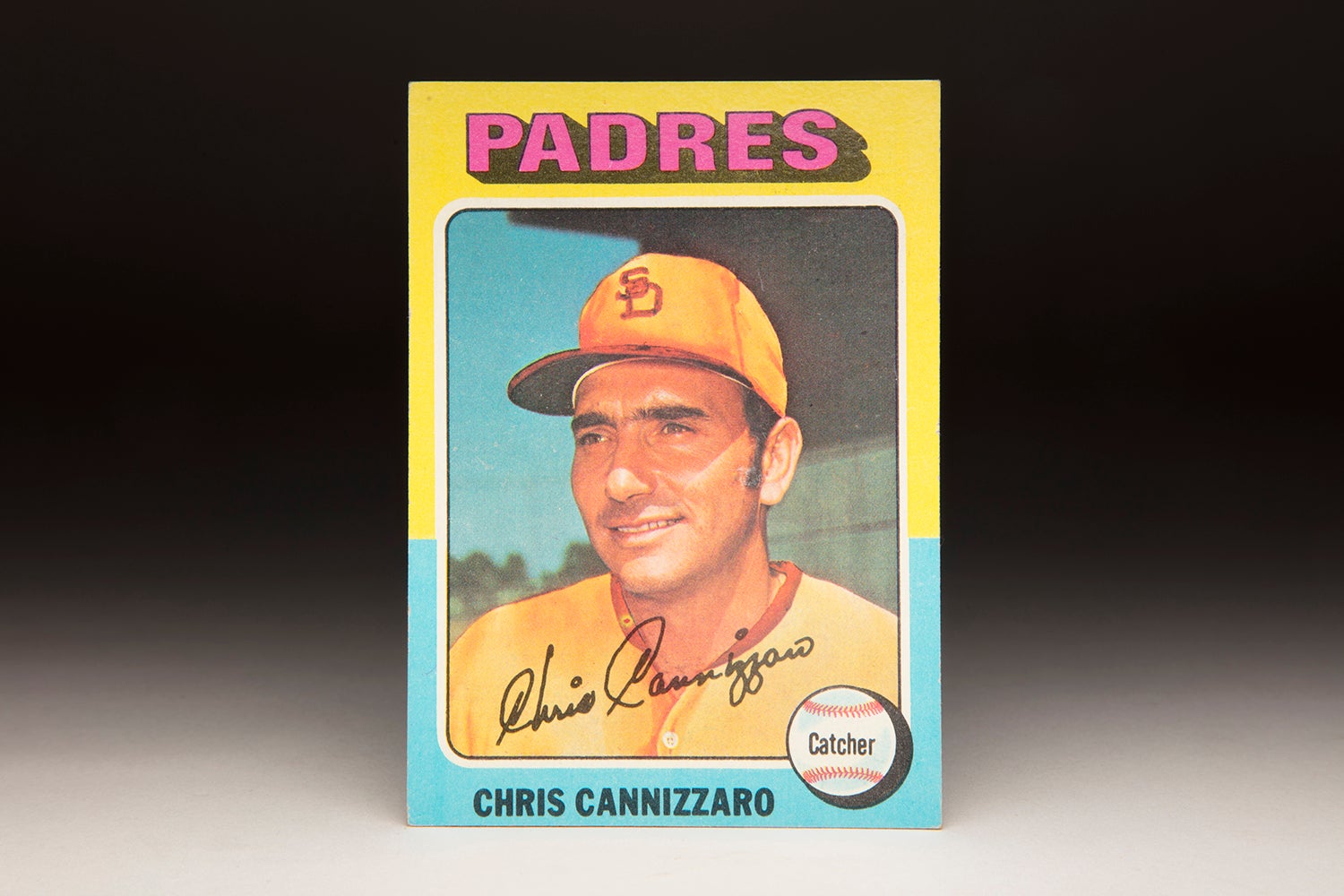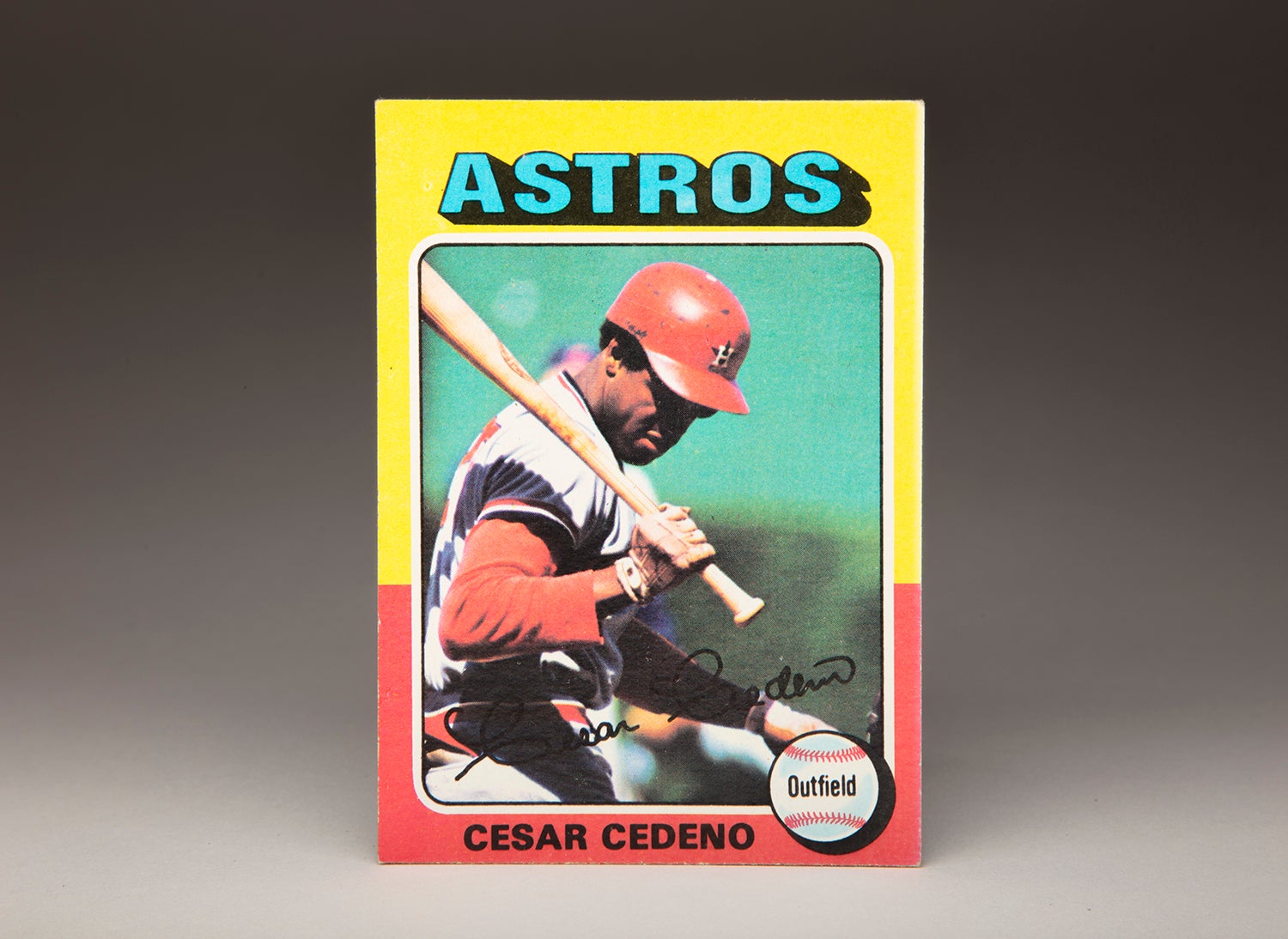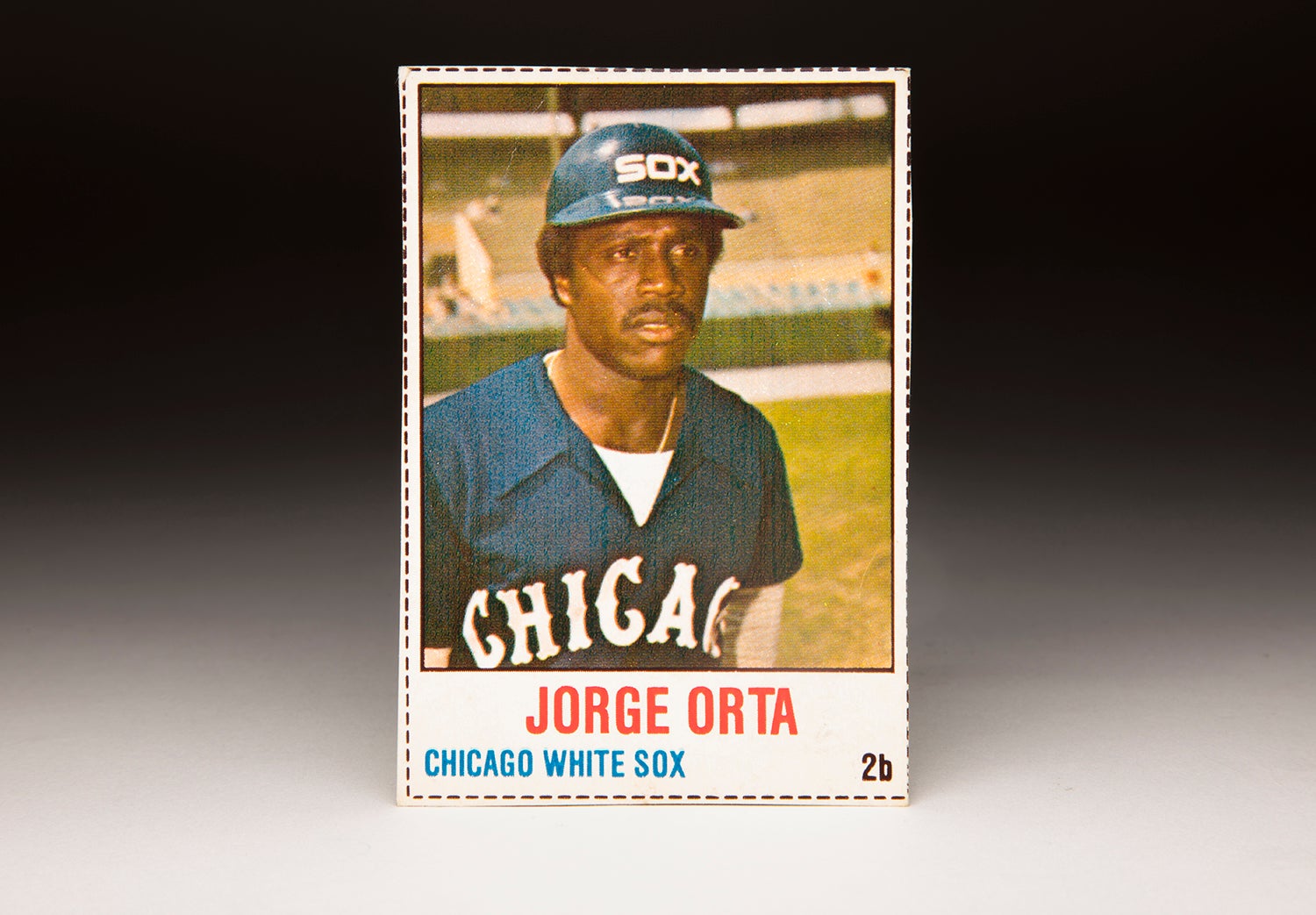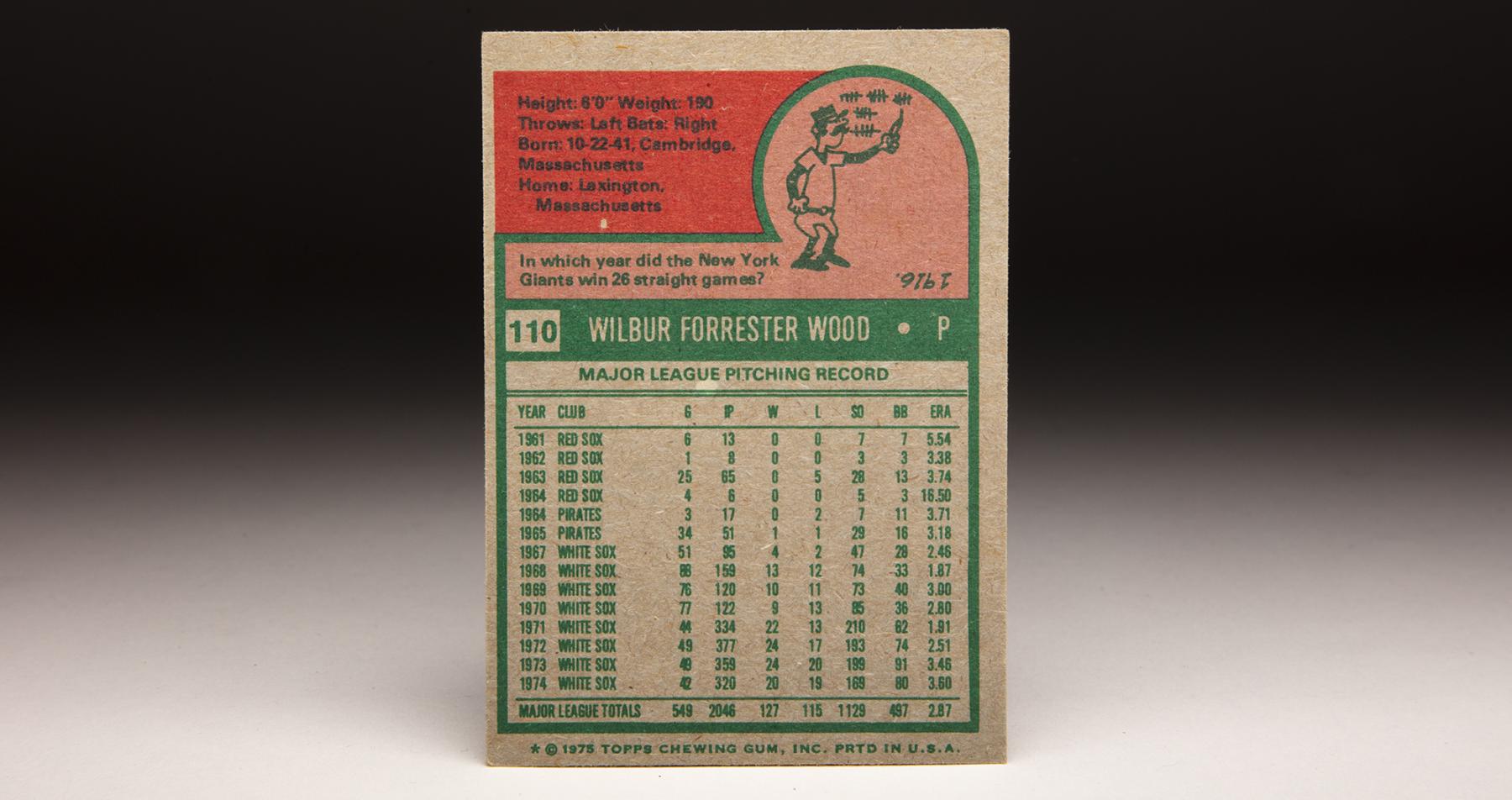- Home
- Our Stories
- #CardCorner: 1975 Topps Wilbur Wood
#CardCorner: 1975 Topps Wilbur Wood
The back of Wilbur Wood’s 1975 Topps card looks like a series of typos.
From 1971-74, his “innings pitched” are listed as 334, 376, 359 and 320. That’s a total of 1,389 innings, which is not even accurate because Topps rounded down those totals to the nearest whole inning, costing Wood an additional 1.1 innings that he worked.
In the modern era of baseball, those figures represent outliers rarely seen in any category. And regardless of how little toll Wood’s knuckleball took on his left arm, they are totals that deserve a second look – on a card that screams “1970s” as only the ’75 Topps set can.
Wood began his career as a highly touted conventional pitcher, relying on a fastball/curve combination to dominate the amateur ranks. Signed by his hometown Boston Red Sox to a “bonus baby” contract in 1960, Wood pitched well in the minors but was unable to stick at the big league level over four seasons from 1961-64. The Red Sox sold his contract to the Pirates in late 1964, and Wood spent all of 1965 in Pittsburgh’s bullpen, pitching in mostly lost-cause games.
Wood was returned to the minors by the Pirates in the spring of 1966, and won 14 games that year for the Triple-A Columbus Jets. But the Pirates did not recall him at any point that year, and following the season Pittsburgh traded Wood to the White Sox in exchange for Juan Pizarro.
Seeing no clear path toward Chicago’s big league roster in Spring Training of 1967, Wood turned to knuckleballer Hoyt Wilhelm. The 44-year-old Wilhelm was already a bullpen ace, and he convinced Wood to commit to the knuckleball fulltime.
In 51 games with the White Sox that year, Wood went 4-2 in 95.1 innings with a tidy 2.45 ERA.
In 1968, Wood burst onto the national scene by appearing in a then-record 88 games, going 13-12 with a 1.87 ERA with 16 saves (which were not an official statistic until the following year).
Wood led the American League in appearances in each of the next two seasons, saving 31 games and winning another 23.
Chuck Tanner took over as White Sox manager at the end of the 1970 season – a campaign where the White Sox lost a franchise-record 106 games.
And through a series of incidents and injuries, Wood became a starter in 1971.
Tanner and new pitching coach Johnny Sain put Wood on a two-start-a-week program, and Wood responded with 22 complete games in 42 starts, posting a 22-13 record with a 1.91 ERA over 334 innings.
Wood finished third in the AL Cy Young Award voting and ninth in the league’s MVP race.
The next season – the last in the AL without the designated hitter – Wood started 49 games, completing 20 and working 376.2 innings – the most of any pitcher in the Live Ball era (post 1919).
A labor dispute limited the White Sox to just 154 games that year, likely costing Wood at least two more starts.
With only three more starting assignments, Wood could have topped the 400-inning mark.
From 1971-75, Wood averaged better than 21 wins and 336 innings per year, earning three All-Star Game selections and three Top 5 finishes in the AL Cy Young Award voting.
In 1976, however, an injury derailed his season and career. In his seventh start of the year, Wood’s left kneecap was shattered on a ball hit back up the middle by the Tigers’ Ron LeFlore. Wood was credited with the victory in Chicago’s 4-2 win at Tiger Stadium, leaving him with a 4-3 record, a 2.24 ERA and five complete games in his seven starts.
He would not pitch again that season, and the 34-year-old Wood was never the same. He pitched a total of 290.2 innings in 1977 and 1978, winning 17 games with a 5.11 ERA.
Becoming a free agent after the 1978 season, Wood found no offers.
“I’m sure I can help some ball club,” Wood said as the spring of 1979 wore on. But despite nibbles from the Cubs, Pirates and other teams, Wood never pitched in the big leagues again.
“I guess all good things must come to an end,” Wood said.
Wood finished his 17-year career with a record of 164-156 and a 3.24 ERA. He appeared in 651 games, starting 297 and completing 114.
In each year except one from 1968-75, Wood either led the American League in appearances or games started.
Wood is one of only five players in history with at least 114 complete games and 50 saves.
The other four include Lefty Grove, Waite Hoyt, Jack Quinn and Wood’s former pitching coach Johnny Sain.
None of the other four pitched after the save became an official statistic in 1969.
And for those who like modern-era stats, consider this: Wood’s 1971 season produced a WAR (Wins Above Replacement) of 11.7. Since then, only four pitchers – Steve Carlton in 1972 (12.1), Dwight Gooden in 1985 (12.2), Roger Clemens in 1997 (11.9) and Pedro Martinez in 2000 (11.7) have reached that mark in any season.
Old school or new metrics, it didn’t matter: For a time, Wilbur Wood was among baseball’s best.
Craig Muder is the director of communications for the National Baseball Hall of Fame and Museum
Related Stories

#CardCorner: 1975 Topps Herb Washington

#CardCorner: 1975 Topps Chris Cannizzaro

#CardCorner: 1975 Topps César Cedeño

#CardCorner: 1978 Hostess Jorge Orta

#CardCorner: 1975 Topps Herb Washington

#CardCorner: 1975 Topps Chris Cannizzaro

#CardCorner: 1975 Topps César Cedeño











